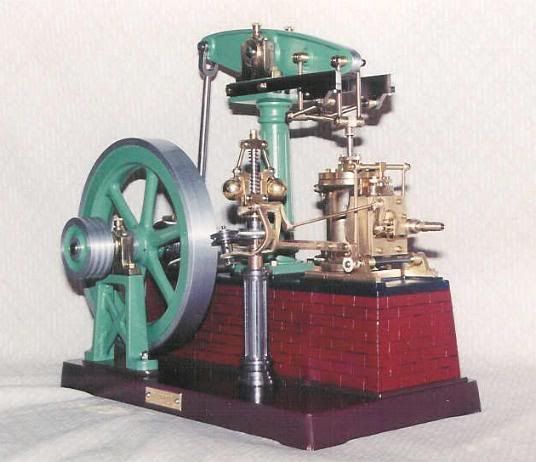Oldmechthings
Well-Known Member
- Joined
- Jan 10, 2008
- Messages
- 153
- Reaction score
- 12
Although maybe not the most efficient design for a steam engine, beam engines are certainly interesting machines to watch running. Anything they lack in efficiency is more than made up in entertainment. The beam engine posted here today is a little more refined than the Coffee Engine that I posted yesterday. This engine very closely follows the Stuart Turner beam engine drawing, but I made my own patterns and castings, and that allowed me to add a few of my own embellishments.

For a simulated masonry base, I reworked a little cutter similar to a slitting saw. It was put in the mill on a extended mandrel and set at the height of a mortar joint, and then I slid the casting past the cutter by hand to scribe the joint. Then the elevation was changed to the next joint line, and so on. The vertical joints were chiseled in with a graver and a small hammer.
A flyball governor was an optional accessory on the Stuart engines and I had no drawing for that, so I simply designed my own. It works nicely, controlling the speed of the engine. I have it set a slow pace which makes it more realistic. Working from someone else's drawing is sometimes easier, but I spent over forty years working at a large metal fabrication and construction company, much of that time doing design engineering, so it comes quite naturally. The only difference between models and the real thing is simply size.

For a simulated masonry base, I reworked a little cutter similar to a slitting saw. It was put in the mill on a extended mandrel and set at the height of a mortar joint, and then I slid the casting past the cutter by hand to scribe the joint. Then the elevation was changed to the next joint line, and so on. The vertical joints were chiseled in with a graver and a small hammer.
A flyball governor was an optional accessory on the Stuart engines and I had no drawing for that, so I simply designed my own. It works nicely, controlling the speed of the engine. I have it set a slow pace which makes it more realistic. Working from someone else's drawing is sometimes easier, but I spent over forty years working at a large metal fabrication and construction company, much of that time doing design engineering, so it comes quite naturally. The only difference between models and the real thing is simply size.




